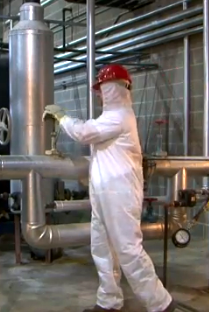Many workers with jobs in industries such as chemical, biohazard, nuclear and petrochemical require or would benefit from the added protection of secondary flame resistant disposable garments. Hazardous exposure to chemical spills, dust, dirt and non-combustible contaminants may increase the risk of injury in the occurrence of flash fire or electric arc.
Moisture such as sweat or liquid contamination can also act as a heat conductor, and when present, could have an impact on the effectiveness of the primary FR garment. Secondary FR disposable garments not only protect primary FR garments, they add an extra layer in regard to repellency, ignition and melting and should be paired for the following reasons:
1. Primary Garment Protection & Improved Performance
Flame Resistant (FR) protective wear is an investment and designed to protect the lives of those working in dangerous environments. These garments are not inexpensive and require care to make sure the protection level is not jeopardized. For example, manufacturers advise against using fabric softeners or bleach, as both products can decrease resistance to ignition.
Additionally, secondary disposable garments protect the investment of FR gear by reducing the extra cleaning that would otherwise be required to remove oils, chemicals and debris. As build up of oils or other soils will reduce the resistance of the garments over time, primary protective wear remains in better condition and lasts longer when worn in conjunction with secondary apparel. Users of disposable FR wear benefit from the ability to strip off the oil or chemical soaked outer layer during the workday and then replace the soiled garment with fresh protection.
2. Added Repellency
The National Fire Protection Agency (NFPA) says that layering can increase the total resistance of protective wear. While the overall protection can only be measured through testing, arc protection ratings do increase in cal/cm² with each additional layer.
When protective clothing is needed for additional repellency in outdoor use, a few factors should be taken into consideration. Primary garment rainwear options are available, providing the arc flash and flame resistance required while protecting the wearer from moisture. Disposable garments can be used for some outdoor applications but if an insect repellant is used, a water-based product is recommended as propellants are flammable.
3. Self–Extinguishing
Flame resistant materials resist ignition and will self-extinguish as soon as the ignition source is removed. The garments do not necessarily protect from thermal injuries in the contact area. The additional layer of self-extinguishing materials provides users with some extra protection against arc flash and sparks. If spilled on or burned, disposable wear can be removed quickly and easily, lessening damage to the FR protection underneath and reducing the chance for thermal injury.
If flammable substances are splashed or spilled on FR wear and ignition occurs, the substance itself will continue to burn until the fuel source is extinguished or fully burned. If this occurs to primary garments, they must be immediately removed and replaced with clean garments. If the substance cannot be cleaned, the primary wear must be taken out of service. With a disposable outer layer, the primary FR clothing typically remains intact for continued use. Additionally, it is proven that in most instances, secondary, disposable FR garments provide enhanced protection for both the user and the primary garment investment.



